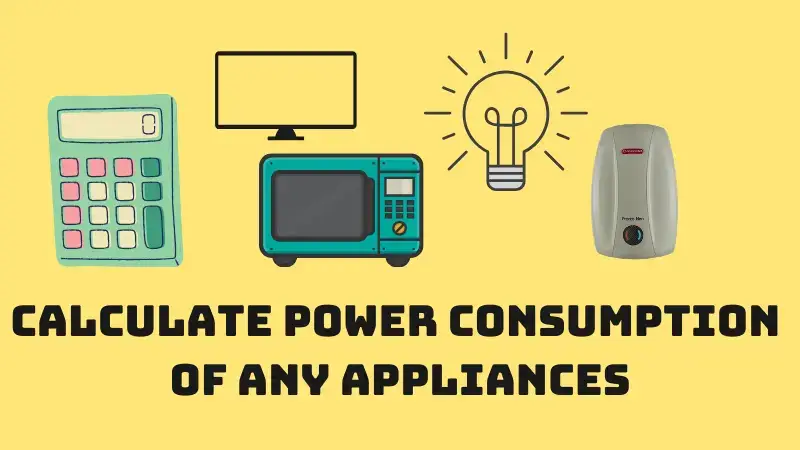
In this article, you will learn the simple yet essential steps to calculate the energy consumption of your home appliances. Understanding how much energy your appliances are using can help you make informed decisions about your electricity usage and ultimately lower your energy bills. By following these easy calculations, you can gain valuable insights into the energy efficiency of your appliances and make adjustments to save both energy and money. So let’s get started and unlock the secrets to calculating energy consumption in your household!
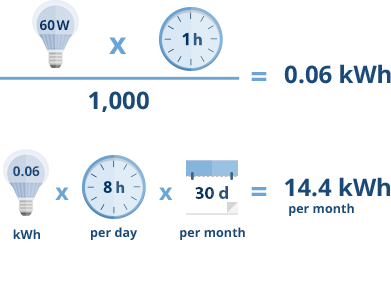
This image is property of www.hydroquebec.com.
Understanding Energy Consumption
What is energy consumption?
Energy consumption refers to the amount of energy consumed or utilized by a particular device, appliance, or system over a given period of time. It is measured in units of energy (such as kilowatt-hours) and is a crucial aspect to consider in our daily lives.
Why is it important to calculate energy consumption?
Calculating energy consumption is important for several reasons. Firstly, it helps us understand and keep track of our energy usage, which is essential for managing our energy expenses. By knowing how much energy different appliances consume, we can make informed decisions about their usage and potentially reduce our electricity bills.
Secondly, calculating energy consumption allows us to identify energy-intensive appliances or devices in our homes. This knowledge enables us to prioritize energy-saving measures and focus on reducing consumption in those areas.
Lastly, understanding energy consumption is vital in developing a more sustainable and environmentally friendly lifestyle. By recognizing the impact of our energy usage, we can take steps to minimize our carbon footprint and contribute to a greener future.
How is energy consumption measured?
Energy consumption is typically measured using units such as kilowatt-hours (kWh). A kilowatt-hour represents the amount of energy consumed when a device with a power rating of one kilowatt operates for one hour. This unit allows us to quantify the energy consumption of different appliances and compare them.
To calculate energy consumption, we multiply the power rating of a device (in kilowatts) by the number of hours it is used. This calculation gives us the total energy consumed in kilowatt-hours. By understanding this measurement, we can make better decisions about energy usage and conservation.
Factors Affecting Energy Consumption
Type of Appliance
The type of appliance plays a significant role in determining energy consumption. Different appliances have varying energy requirements, depending on their intended purpose and complexity. For example, heating appliances such as water heaters or space heaters tend to consume more energy than smaller devices like lamps or clocks.
Appliance Power Rating
The power rating of an appliance indicates the amount of power it requires to operate effectively. It is usually measured in watts (W) or kilowatts (kW). The power rating provides an estimate of the energy consumption of an appliance when it is operating at its maximum capacity.
Usage Hours
The number of hours an appliance is used directly affects its energy consumption. Appliance usage can vary greatly depending on personal habits, lifestyle, and specific needs. For instance, an appliance used for several hours per day, such as a refrigerator, will consume more energy compared to an appliance used only for a few minutes, like a toaster.
Energy Efficiency Rating
Energy-efficient appliances are designed to minimize energy consumption while still providing the desired functionality. The energy efficiency rating of an appliance gives us an idea of how well it utilizes energy. Appliances with higher energy efficiency ratings consume less energy for the same level of performance compared to those with lower ratings. When purchasing new appliances, it is beneficial to consider models with higher energy efficiency ratings to save on energy costs in the long run.
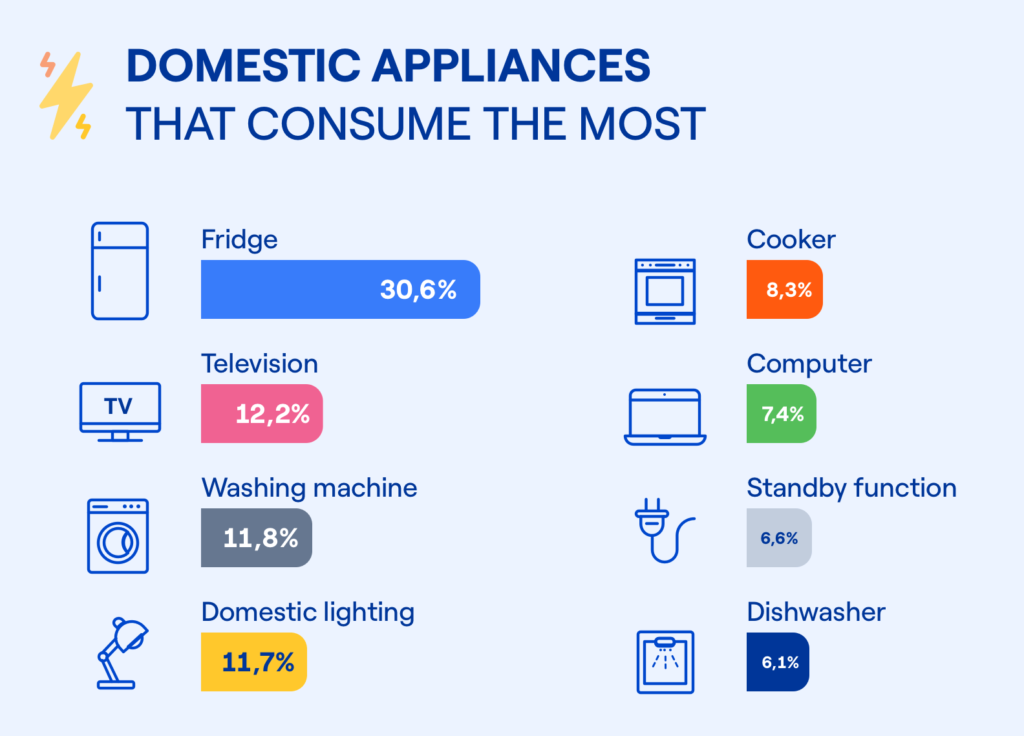
This image is property of www.endesa.com.
Understanding Power Rating
What is power rating?
The power rating of an appliance represents the rate at which it consumes electrical power. It is typically stated in watts or kilowatts and indicates the amount of energy consumed during its operation.
How is power rating measured?
The power rating of an appliance can be measured in various ways. For smaller devices like lamps or clocks, the power rating can be directly specified by the manufacturer on the product or packaging. For larger appliances, such as washing machines or refrigerators, the power rating may be included in the user manual or displayed on a label attached to the appliance.
In some cases, the power rating may also be calculated by measuring the electrical current flowing through the appliance and multiplying it by the voltage applied. However, it is important to note that power ratings can vary depending on the mode of operation or specific settings of the appliance.
Calculating Energy Consumption
Step 1: Gather Information
To calculate energy consumption, you will need the following information:
- The power rating of the appliance, usually stated in watts (W) or kilowatts (kW).
- The number of hours the appliance is used per day.
Step 2: Convert Power Rating
If the power rating is given in watts, convert it to kilowatts by dividing it by 1000. This conversion is necessary as energy consumption is typically measured in kilowatt-hours.
Step 3: Calculate Daily Energy Consumption
Multiply the power rating of the appliance in kilowatts by the number of hours it is used per day. This will give you the energy consumption of the appliance for a single day in kilowatt-hours.
Step 4: Calculate Monthly Energy Consumption
To calculate the monthly energy consumption, multiply the daily energy consumption by the number of days in a month.
Step 5: Estimate Annual Energy Consumption
To estimate the annual energy consumption, multiply the monthly energy consumption by 12.
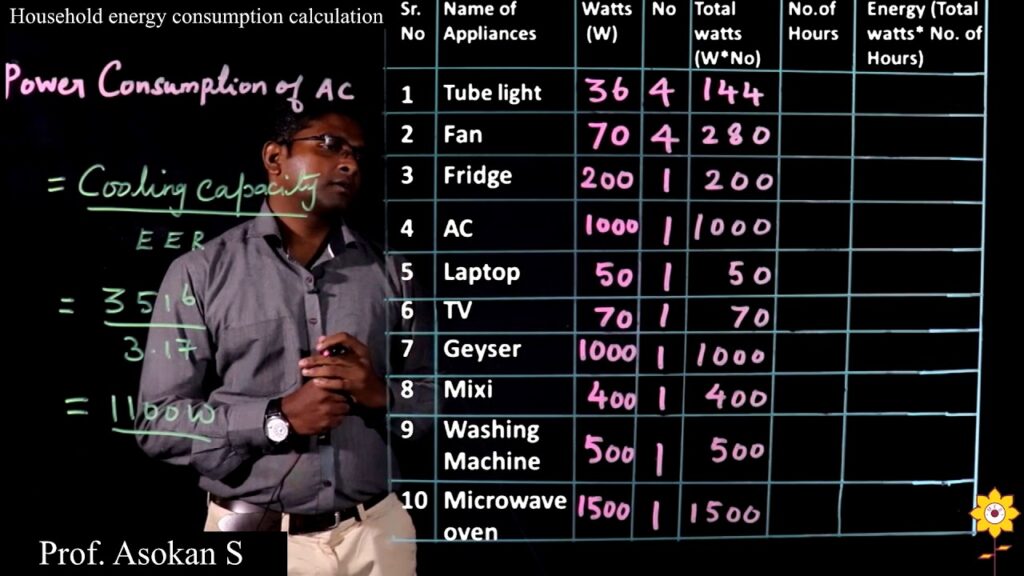
This image is property of i.ytimg.com.
Examples and Calculations
Example 1: Calculating the energy consumption of a refrigerator
Let’s assume the power rating of the refrigerator is 150 watts and it is used for an average of 10 hours per day.
Step 1: Gather Information
- Power rating: 150 watts
- Daily usage: 10 hours
Step 2: Convert Power Rating The power rating of the refrigerator in kilowatts is 150 watts divided by 1000, which equals 0.15 kilowatts.
Step 3: Calculate Daily Energy Consumption Multiply the power rating (0.15 kW) by the daily usage (10 hours): 0.15 kW x 10 hours = 1.5 kWh
Therefore, the refrigerator consumes 1.5 kilowatt-hours of energy per day.
Step 4: Calculate Monthly Energy Consumption Multiply the daily energy consumption (1.5 kWh) by the number of days in a month. Assuming there are 30 days in the month: 1.5 kWh x 30 days = 45 kWh
The refrigerator consumes approximately 45 kilowatt-hours of energy per month.
Step 5: Estimate Annual Energy Consumption Multiply the monthly energy consumption (45 kWh) by 12: 45 kWh x 12 months = 540 kWh
The estimated annual energy consumption of the refrigerator is 540 kilowatt-hours.
Example 2: Calculating the energy consumption of a washing machine
Let’s say the power rating of the washing machine is 500 watts and it is used for an average of 2 hours per day.
Step 1: Gather Information
- Power rating: 500 watts
- Daily usage: 2 hours
Step 2: Convert Power Rating The power rating of the washing machine in kilowatts is 500 watts divided by 1000, which equals 0.5 kilowatts.
Step 3: Calculate Daily Energy Consumption Multiply the power rating (0.5 kW) by the daily usage (2 hours): 0.5 kW x 2 hours = 1 kWh
Therefore, the washing machine consumes 1 kilowatt-hour of energy per day.
Step 4: Calculate Monthly Energy Consumption Multiply the daily energy consumption (1 kWh) by the number of days in a month. Assuming there are 30 days in the month: 1 kWh x 30 days = 30 kWh
The washing machine consumes approximately 30 kilowatt-hours of energy per month.
Step 5: Estimate Annual Energy Consumption Multiply the monthly energy consumption (30 kWh) by 12: 30 kWh x 12 months = 360 kWh
The estimated annual energy consumption of the washing machine is 360 kilowatt-hours.
Interpreting the Results
Understanding energy consumption units
Energy consumption units, such as kilowatt-hours (kWh), provide a measurement of the total energy consumed by an appliance over a specific period. It is important to understand these units to gauge the impact of energy usage accurately. The higher the number of kilowatt-hours consumed, the more energy the appliance consumes.
Comparing energy consumption between appliances
By comparing the energy consumption of different appliances, we can make informed decisions about which ones are more energy-efficient. Appliances with lower energy consumption will contribute to lower electricity bills and have a smaller environmental impact.
Identifying energy-saving opportunities
Calculating and analyzing energy consumption allows us to identify potential areas for energy-saving improvements. By recognizing appliances or devices that consume excessive energy, we can implement strategies or make changes to reduce energy consumption. This can include using appliances more efficiently, setting timers, or investing in energy-saving models.
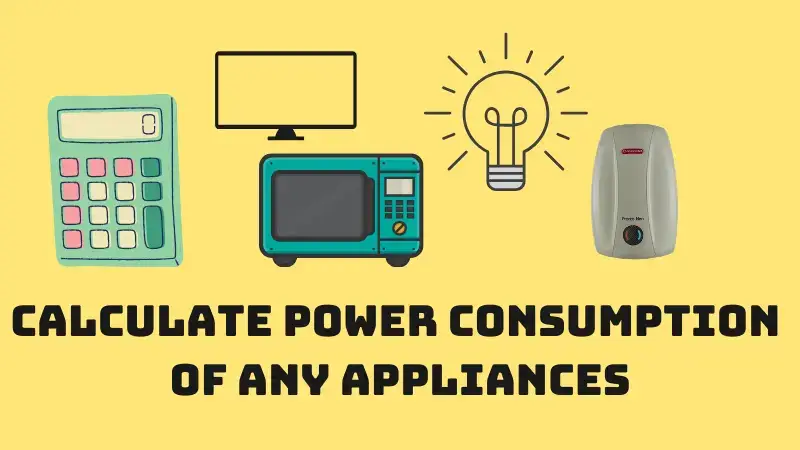
This image is property of letsavelectricity.com.
Monitoring and Tracking Energy Consumption
Using energy meters
Energy meters, also known as energy monitors or smart meters, are devices that measure and display real-time energy consumption. These meters can be installed in a home or specific appliances to help monitor and track energy usage. By having access to instant energy consumption data, individuals can make immediate adjustments to their usage habits and better manage their energy consumption.
Keeping a consumption log
Maintaining a consumption log is another effective way to monitor and track energy consumption. By recording the usage hours and energy consumed by each appliance over a period of time, it becomes easier to identify patterns and areas for improvement. Keeping a consumption log also helps in accurately estimating monthly and annual energy consumption.
Tracking savings and improvements
Regularly tracking energy consumption allows individuals to assess the impact of energy-saving measures and identify potential savings. By comparing the energy consumption before and after implementing changes or upgrades, it becomes possible to gauge the effectiveness of energy-efficient practices and technologies.
Tips for Reducing Energy Consumption
Choose energy-efficient appliances
When purchasing new appliances, always look for energy-efficient models with higher energy efficiency ratings. These appliances are designed to use less energy while still providing the same level of functionality. Investing in energy-efficient appliances can lead to significant long-term energy savings.
Unplug devices when not in use
Many appliances and electronic devices continue to consume energy even when they are not actively being used. To minimize this “phantom” or “standby” energy consumption, unplug devices when they are not in use or utilize power strips with switches to easily turn off multiple devices at once.
Optimize appliance usage
Using appliances more efficiently can contribute to reduced energy consumption. For example, when using a dishwasher or washing machine, try to run full loads to maximize their efficiency. Additionally, adjusting the temperature settings on appliances such as water heaters or refrigerators can lead to energy savings.
Utilize energy-saving features
Most appliances come with energy-saving features that can be enabled to reduce energy consumption. Utilize these features, such as sleep modes or timers, to automatically power off or reduce the energy consumption of appliances during periods of inactivity.
Implement smart home technology
Smart home technology allows for the automation and control of various devices and appliances. By integrating smart devices and utilizing features such as motion sensors or programmable thermostats, it becomes easier to optimize energy usage and achieve further energy savings.
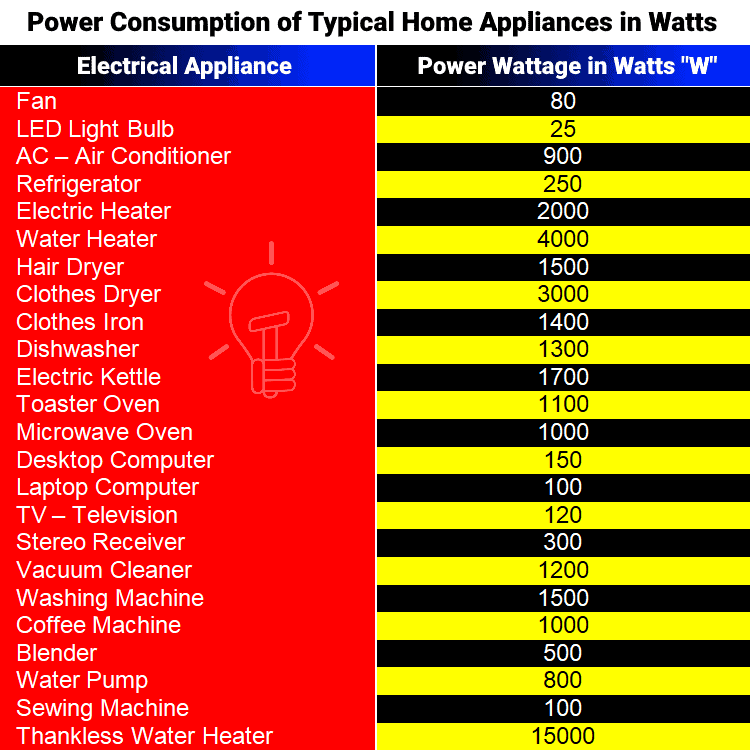
This image is property of www.electricaltechnology.org.
Common Misconceptions
Leaving appliances on standby consumes negligible energy
While devices in standby mode consume less energy compared to when they are actively being used, the cumulative energy consumption from multiple appliances on standby can still be significant over time. Therefore, it is advisable to completely power off or unplug devices when not in use to minimize energy waste.
Energy consumption is the same for all appliances of the same type
Energy consumption can vary significantly even among appliances of the same type. Factors such as power rating, energy efficiency, and usage habits can all contribute to differences in energy consumption. It is important to consider these factors individually when assessing the energy consumption of specific appliances.
Energy-efficient appliances are too expensive
While energy-efficient appliances may have a higher initial cost compared to their conventional counterparts, the long-term savings in energy bills can offset this investment. Additionally, various energy-efficient appliances may qualify for energy rebates or incentives, further reducing the cost of upgrading to more efficient models.
Conclusion
Understanding energy consumption is crucial for effectively managing energy usage, reducing costs, and promoting sustainability. By calculating energy consumption, considering factors such as appliance type, power rating, and usage habits, individuals can make informed decisions about energy usage and identify opportunities for improvement. Monitoring and tracking energy consumption, implementing energy-saving measures, and dispelling common misconceptions contribute to a more energy-conscious lifestyle, benefiting both our finances and the environment.





